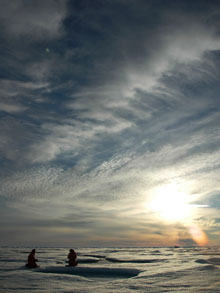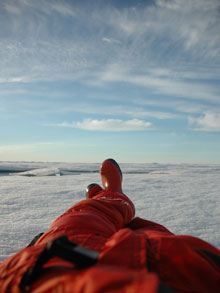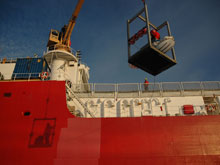
Chief Scientist Rolf Gradinger is silhouetted by the Arctic sun while collecting one of the last ice cores of the cruise. Click image for larger view.
Nightlights
July 22, 2005
Jeremy Potter
Mission Coordinator
NOAA Ocean Exploration
![]() Scenes of Hidden Ocean scientists going to work on the ice during an unusually beautiful night on July 22nd. (mp4, 2.21 MB)
Scenes of Hidden Ocean scientists going to work on the ice during an unusually beautiful night on July 22nd. (mp4, 2.21 MB)
WHAH!! WHAH!! WHAH!! Though the annoying alarm disturbs my sound slumber, it isn’t until the pager falls on my forehead that I fight the urge to roll over and keep snoozing. Yet again, I promise myself not to leave the pager on vibrate mode on the shelf above my head when going to sleep. I groggily grab the pager to turn off the alarm, now blaring in my left ear. The display shows ‘11:30 PM’, the middle of the night.
Instinctively, I sit up and flip on the light switch. Nothing happens. I try again. . . . again nothing. As the fog of sleep slowly dissipates, I realize the light is actually working; it just isn’t making any difference. It is already daylight outside. Let me rephrase that. . . it is STILL daylight outside.
This is a lesson I relearn nearly every morning and am reminded of every time I walk outside at ‘night.’ Just because my body tells me it is nighttime, doesn’t mean that it’s dark in the Arctic.
North of the Arctic Circle, there are tremendous seasonal changes in the length of days and nights. Variations can range from 24 hours of constant daylight (“midnight sun”) in the summer to 24 hours of darkness in the winter. In summertime, the sun is always above the horizon at the North Pole (90o N), circling the Pole once every day. It is highest in the sky at the Summer Solstice, after which it moves closer to the horizon, until it sinks below the horizon, at the Fall Equinox. Though the HEALY is at approximately 74o N, north of the Arctic Circle but well south of the North Pole, we are still so far north we experience daylight practically 24 hours a day.
Suddenly remembering why I set my alarm for the middle of the night, I quickly climb into my standard garb, gray sweatpants and a navy blue sweatshirt. I hurry down to the main lab to join the other members of the science team headed out to collect samples from the ice floe at Station 14. I jump into a mustang suit and don my work boots. At midnight, I step outside onto the aft deck with my sunglasses on.
About 30 minutes later, the ice party- a smattering of science divers as well as Sea Ice, Marine Mammal and Primary Productivity team members- span out along the ice floe and begin setting up equipment. Although this is a routine we have gone through numerous times already, it certainly doesn’t feel routine tonight. The beauty of our surroundings is stunning. Wispy clouds provide texture against a crisp blue sky. The golden sun hovers just above the horizon, casting dazzling light across shimmering Arctic ice while mysterious shadows creep across the ice surface. Pastel lights refract off melt ponds and color the ice around it; the multitude of color seems just a bit bolder tonight.
Knowing this is the last full ice station, I try to take-in and remember all of my surroundings. Who knows if we’ll ever have a chance to experience it again? I turn my head and squint in the direction of Rolf. Despite looking almost directly into the setting, or perhaps rising sun, I can see an enormous smile on his face as he plucks with practiced precision yet another meter-long core from the ice.
Rolf's disposition displays the distinct sense of wonder and excitement that envelops us all tonight. Maybe it has something to do with the brilliant blue sky, or perhaps the calm and stillness that's only palpable while the ship is 'sleeping.' I decide that it is none of those alone, or rather; it is all of them tangled up together in a pervading sense of contentment. We simply love what we do.
Sign up for the Ocean Explorer E-mail Update List.




































